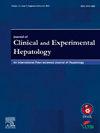进行性家族性肝内胆汁淤积症(PFIC)的免疫组织化学:形态学和遗传学之间的桥梁
IF 3.2
Q2 GASTROENTEROLOGY & HEPATOLOGY
Journal of Clinical and Experimental Hepatology
Pub Date : 2025-03-28
DOI:10.1016/j.jceh.2025.102562
引用次数: 0
摘要
进行性家族性肝内胆汁淤积症(PFIC)是胆汁分泌和转运缺陷引起的异质性疾病。PFIC有多种亚型,具有不同的表现、实验室检查、治疗、进展和预后。基因分析是诊断的金标准,但它昂贵、耗时,而且不易获得。在这项研究中,免疫组织化学(IHC)被评估为识别PFIC亚型并将其与其他原因的儿童胆汁淤积症区分开来的工具。方法采用遗传确诊PFIC组(n = 40)和非PFIC组(n = 20)。从医院信息系统中记录临床病史和实验室调查。PFIC亚型1、2、3、4、5和6分别显示ATP8B1、ABCB11、ABCB4、紧密连接蛋白2 (TJP2)、NR1H4和MYO5B基因突变。IHC已应用于胆汁盐输出泵(BSEP)、多药耐药蛋白3 (MDR3)、TJP2、Claudin 1、farnesoid X受体(FXR)、MYO5B。结果BSEP、MDR3、TJP2、MYO5B在PFIC 1亚型中100%呈阳性,在PFIC 2、3、4、6亚型中分别为90.9%、84.6%、100%、100%呈阴性。PFIC患者与非PFIC患者BSEP (P = 0.044)、MDR3 (P = 0.022)和TJP2 (P <;0.001)。与非PFIC患者相比,BSEP诊断PFIC 2的敏感性和特异性分别为90.9%和95%,MDR3诊断PFIC 3的敏感性和特异性分别为84.6%和95%,TJP2诊断PFIC 4的敏感性和特异性分别为100%和95%,MYO5B“s诊断PFIC 6。结论免疫染色BSEP、MDR3、TJP2和MYO5B标记物可区分PFIC的不同亚型,并可区分PFIC与非PFIC患者。本文章由计算机程序翻译,如有差异,请以英文原文为准。

Immunohistochemistry in Progressive Familial Intrahepatic Cholestasis (PFIC): Bridging Gap Between Morphology and Genetics
Background/Aims
A heterogeneous group of disorders caused by bile secretion and transport defects is progressive familial intrahepatic cholestasis (PFIC). PFIC has various subtypes with different presentations, laboratory findings, treatments, progression, and prognosis. Genetic analysis is the gold standard for diagnosis but is costly, time-consuming, and not readily available. In this study, immunohistochemistry (IHC) was evaluated as a tool for identifying subtypes of PFIC and differentiating them from other causes of pediatric cholestasis.
Methods
The study included genetically confirmed PFIC (n = 40) and non-PFIC group (n = 20). Clinical history and laboratory investigations were recorded from the hospital information system. PFIC subtypes 1,2,3,4,5, and 6 showed the genetic mutation in ATP8B1, ABCB11, ABCB4, tight junction protein 2 (TJP2), NR1H4, and MYO5B, respectively. IHC has been applied for bile salt export pump (BSEP), multidrug resistance protein 3 (MDR3), TJP2, Claudin 1, farnesoid X receptor (FXR), and MYO5B.
Results
IHC staining for BSEP, MDR3, TJP2, and MYO5B was positive in 100% of PFIC 1 and negative in 90.9%, 84.6%, 100%, and 100%, respectively, of the PFIC subtypes 2, 3, 4, and 6. Significant differences were noted between PFIC and non-PFIC patients for BSEP (P = 0.044), MDR3 (P = 0.022), and TJP2 (P < 0.001). In comparison with the non-PFIC patients, BSEP’s sensitivity and specificity for diagnosing PFIC 2 was 90.9% and 95%, MDR3’s for diagnosing PFIC 3 was 84.6% and 95%, TJP2 for PFIC 4 was 100% and 95%, and MYO5B’'s for PFIC 6.
Conclusion
Immunostaining for the markers BSEP, MDR3, TJP2, and MYO5B can differentiate various PFIC subtypes and distinguish between PFIC and non-PFIC patients.
求助全文
通过发布文献求助,成功后即可免费获取论文全文。
去求助
来源期刊

Journal of Clinical and Experimental Hepatology
GASTROENTEROLOGY & HEPATOLOGY-
CiteScore
4.90
自引率
16.70%
发文量
537
审稿时长
64 days
 求助内容:
求助内容: 应助结果提醒方式:
应助结果提醒方式:


